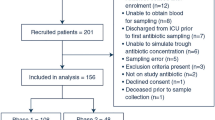Summary
We are reporting on a comparison of serum concentrations of cefotaxime during and after surgery and on its passage to the wound fluid after surgery. Five patients undergoing mastectomy and dissection of the axillary lymph nodes for breast cancer were studied. Serum concentrations were compared after 2 g of cefotaxime dissolved in 20 ml of saline had been administered by i.v. bolus injection intraoperatively during general anaesthesia and six to eight days postoperatively in a conscious state. After intraoperative administration under general anaesthesia, cefotaxime serum concentrations were 157.3 mg/l at 15 min, 87.5 mg/l at 30 min, 43.08 mg/l at 1 h, 15.54 mg/l at 2 h and 9.56 mg/l at 3 h. In a conscious state, cefotaxime serum concentrations were 122.0 mg/l at 15 min, 84.35 mg/l at 30 min, 47.63 mg/l at 1 h, 18.2 mg/l at 2 h and 9.63 mg/l at 3 h, comparable to the time course under general anaesthesia. The half-life of cefotaxime was 0.86 h under general anaesthesia and 0.92 h in a conscious state. Urinary recovery of cefotaxime (0 to 3 h) under anaesthesia and in a conscious state was 53.8% and 56.3%, respectively (as reported previously for a non-surgical state). Samples of wound fluid were taken at the completion of surgery from the drain inserted subcutaneously into the wound or by means of a tracheal aspirator kit attached to a portable aspirator. Cefotaxime concentrations were determined postoperatively on days six to eight, when the wound fluid became no longer serous. The mean wound fluid concentration of cefotaxime was 5.53 mg/l after 2 h, 16.7 mg/l (peak) after 3 h, 14.65 mg/l after 4 h, 12.25 mg/l after 5 h and 7.9 mg/l after 6 h. Similar studies with other cephalosporins will also be mentioned for comparison.
Zusammenfassung
Wir berichten über Serumkonzentrationen von Cefotaxim während und nach chirurgischen Eingriffen und seine Penetration in Wundsekret nach Mammakarzinom-Operation. Fünf Patientinnen, bei denen eine Mastektomie mit Lymphknoten-Dissektion durchgeführt wurde, erhielten 2 g Cefotaxim in 20 ml physiologischer Kochsalzlösung durch i.v. Bolusinjektion während der Operation unter Allgemeinanästhesie und postoperativ am sechsten bis achten Tag in wachem Zustand. Die in der jeweiligen Untersuchung bestimmten Serumspiegel betrugen unter Allgemeinnarkose nach 15 min 157,3 mg/l, nach 30 min 87,5 mg/l, nach 1 h 43,08 mg/l, nach 2 h 15,54 mg/l und nach 3 h 9,56 mg/l. Im wachen Zustand wurden entsprechend 15 min nach Injektion 122,0 mg/l, nach 30 min 84,35 mg/l, nach 1 h 47,63 mg/l, nach 2 h 18,2 mg/l und nach 3 h 9,63 mg/l gemessen. Die Halbwertszeit von Cefotaxim unter Allgemeinnarkose betrug 0,86 h und im wachen Zustand 0,92 h. Die Harnrecovery von Cefotaxim im Zeitraum 0 bis 3 h nach Applikation betrug unter Narkose 53,8% und im wachen Zustand (entsprechend früheren Mitteilungen bei nichtchirurgischen Patienten) 56,3%. Nach der Operation wurde aus dem subkutanen Drain durch ein tragbares Absaugegerät (mit Absaugvorrichtung für Trachealsekret) Wundsekret gewonnen. Die Cefotaximkonzentrationen wurden am sechsten bis achten postoperativen Tag, wo das Wundsekret nicht mehr mit Serum identisch war, bestimmt. Die Wundsekretkonzentration betrug im Mittel nach 2 h 5,53 mg/l, nach 3 h 16,7 mg/l (Spitzenwert), nach 4 h 14,65 mg/l, nach 5 h 12,25 mg/l und nach 6 h 7,9 mg/l. Zum Vergleich werden ähnliche Studien mit anderen Cephalosporinen dargestellt.
Similar content being viewed by others
Literature
Cefotaxime: A report of the investigators' group for cefotaxime at the new drug symposium in the 27th Congress of Japan Society of Chemotherapy (Fukuoka), 1979.
Ceftriaxone: A report of the investigators' group for ceftriaxone at the new drug symposium in the 30th Congress of Japan Society of Chemotherapy (Sendai), 1982.
Sakai, K. Postoperative infections. Chemotherapy 31 (1983) 996–998.
Okamoto, A., Okubo, A., Sawada, Y. The effect of anesthesia and other factors on blood levels of antibiotics in surgical patients. Chemotherapy 21 (1973) 1348–1349.
Hanatani, Y., Fukutomi, T., Yokoyama, I., Arai, T., Yamada, Y., Saito, T. A clinical study about penetration of antibiotics into wound exudate after radical mastectomy. Chemotherapy 31 (1983) 952–956.
Bagley, D. H., MacLowry, J., Beazley, R. M., Gorschboth, C., Ketcham, A. S. Antibiotic concentration in human wound fluid after intravenous administration. Ann. Surg. 188 (1978) 202–208.
Author information
Authors and Affiliations
Rights and permissions
About this article
Cite this article
Ueda, T., Fujimoto, M. & Sakai, K. Studies of cefotaxime serum concentrations during surgery under general anaesthesia and its passage to the wound fluid after surgery for breast cancer. Infection 13 (Suppl 1), S43–S45 (1985). https://doi.org/10.1007/BF01644217
Issue Date:
DOI: https://doi.org/10.1007/BF01644217




